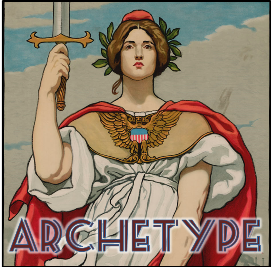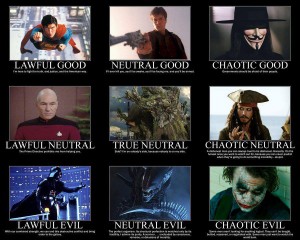 You don’t have to be a dyed-in-the-wool Jungian to recognize that archetypes are a core element in storytelling, whether they come from some deep-rooted collective unconscious or are merely persistent cultural constructs.
You don’t have to be a dyed-in-the-wool Jungian to recognize that archetypes are a core element in storytelling, whether they come from some deep-rooted collective unconscious or are merely persistent cultural constructs.
You don’t even have to like the term “archetype.” Call them what you like: tropes, memes, patterns, threads, modes, models, Platonic forms, şurôt, whatever.
But, no matter what you call them or why they exist, they do exist, and they have undeniable storytelling power.
_
SO MANY POSSIBILITIES
There are lots of typological systems out there. The zodiac is essentially a 12-point archetype set, and many of us are familiar with the Myers-Briggs and Big Five personality schemes. Any of these could be used to inform storytelling; readers and critics use them to analyze characters all the time.
Is Gregory House an INTP or INTJ? A Capricorn or a Scorpio?
You don’t even have to believe these systems are perfectly applicable to real human personalities to see how they can help understand the power of fictional characters. For example, the Jungian introvert-extrovert duality (mirrored in the zodiac’s feminine-masculine duality and in Daoism’s ying and yang) are clearly evident in most Odd Couple and “buddy film” storylines.
 Think Holmes and Watson. Think Doc Holiday and Wyatt Earp. Think McCartney and Lennon.
Think Holmes and Watson. Think Doc Holiday and Wyatt Earp. Think McCartney and Lennon.
We also have the Seven Sins, the I Ching, the four classical humors/elements, the Tarot, the 99 Names of Allâh, the bhávas and rasas, Dumezil’s tripartite scheme … the list of possibilities is pretty extensive. Since my formal training is in comparative religion, I’ve pretty much seen ’em all.
And, let’s not forget the popular role-playing alignment system from Advanced Dungeons and Dragons (see graphic to the right) with its cross-referencing of Lawful and Chaotic, Good and Evil. Archetypal systems are all around us.
_
THE “WRITING ARCHETYPES” SERIES
I’m not going to adhere to any one of these schemes, but I am going to write some pieces on imbuing stories with power using archetypal roles, scenes, and plot points.
I think the term “roles” is fairly self-explanatory. We’re talking Heroes and Companions, Roughs and Gurus, Proximate Villains and Ultimate Villains, Comic Couples and Hordes. We’ll talk about them all.
I use the term “scene” to mean an archetypal setting where an archetypal event often takes place, like the tree under which people gain new information, whether we’re talking about Gautama meditating, Óðinn hanging himself, Adam and Eve having a forbidden snack, or Isaac Newton getting bonked on the head.
And “plot points”? I’ll be diving deeper than the classic scriptwriting plot points at the start of Acts II and III, although those count as well. Smaller points are just as important, like Betrayer Makes Good (AKA Abandoner Returns), or Companion Gets Dunked, or Hero Digs Deep Down. Blake Snyder became a storytelling sensation with a book named for a plot point: the Save The Cat! moment. Iconic plot points like this appear in a wide variety of stories, and examining them side-by-side can reveal why they are such powerful elements in storytelling.
Coming soon, the first installment: The Hero.
_
FUNCTIONAL GLOSSARY
Here is some basic language that I’ll be using, the ideas of which are adapted from comparative religion:
conflation – When one character, scene, or plot point carries the energy of two archetypes, for example how Hector Barbossa fulfills both the Villain and Guru roles in Curse of the Black Pearl.
double – When an archetype gets split in two, often to enable a mirror character to contrast different aspects of the archetype, for example how Aragorn and Boromir contrast different aspects of the Rough archetype in The Fellowship of the Ring.
Guru – I’ll use this term instead of the more common Mentor, simply because the word “mentor” has been exapted by pop business culture.
Hero – I know Hero smacks of Joseph Campbell devotion, and there is a trend to revert to the ancient Greek terms “protagonist” and “antagonist” rather than referring to Heroes and Villains, good and evil. However, although we can avoid the terms hero and villain, but we cannot avoid the psychological reality of how the human narrative instinct receives those roles in stories. The protagonist will always be the stand-in for the listener, by either positive or negative example. If she wins, it’s an adventure or comedy. If she loses, it’s a tragedy. Either way, the main character is the Hero of the story, like it or not.
reversal – When an archetype shows up as the opposite of what it normally should be. For example, a Guru who turns out to be an idiot, or a Loner archetype that manifests as Twins. This happens a lot in stories with a satirical element, for example a Coen Brothers adaptation of an already satirical novel like True Grit.
Villain – This is the term I’ll be using instead of “antagonist,” because this character is going to be received as a hostile other regardless of how sympathetic or well-rounded she is written. To call this role the Evil in the story is a moral extreme, but to reduce the role to neutral antagonism is the opposite extreme, and it denies the psychological reality of human narrative instinct. We may not want antagonists to suffer incommensurate to the trouble they make for the Hero (after all, many romcom “villains” end up hooking up with a secondary character in the Romantic Save point of the denouement) but whether they succeed or fail changes the tone of the work. When the Villain fails, it is an adventure or comedy. When the Villain succeeds, it is a tragedy.

Runs with Wolves
November 12, 2013 at 8:39 pm
I like your broad approach to archetypal matter – and, I have had the thought numerous times that you’d be interesting to converse with on this topic because of the background you’ve had in religion, which I was aware of previously, well, to someone like myself who does not have the training but only an intuitive awareness.
Glossary looks interesting, though arguably ‘Guru’ has also been exapted in a similar manner to ‘mentor’.. heh. Villain is great.
Nice to see a good, definitive treatment of these things.